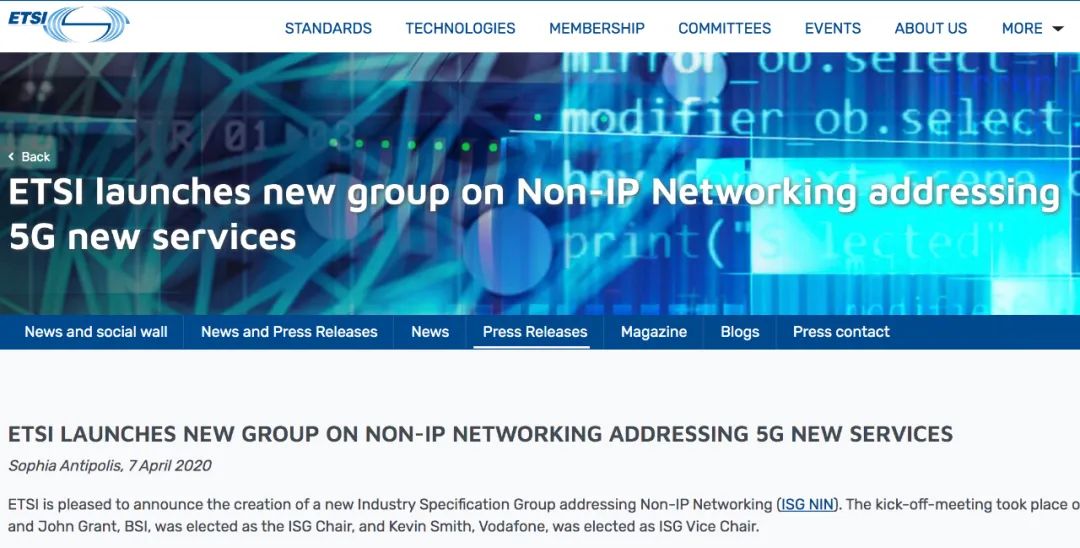For more advanced 5G services, TCP/IP is considered suboptimal.
On April 7, the European Telecommunications Standards Institute (ETSI) announced the establishment of a new industry specification working group, “Non-IP Networking” (ISG NIN).

The goal of this working group is to research and develop new network protocols for 5G networks to replace TCP/IP.
The press release stated that in 2015, some mobile operators discovered issues with the TCP/IP-based technologies used in 4G networks.
Since the TCP/IP protocol was originally designed for the internet and not for mobile communication networks,when mobile communication networks introduced TCP/IP, it added complexity in terms of mobility, security, and QoS, resulting in lower spectrum efficiency. Subsequent patches and alternatives to address these issues have led to increased costs, latency, and power consumption.
Therefore,for more advanced 5G services, TCP/IP is considered suboptimal.
To address this, ETSI established the “Next Generation Protocol” industry specification working group (ISG NGP) in 2015, tasked with analyzing these problems and proposing alternative solutions.
ISG NGP has identified candidate technologies that can directly address these issues, significantly reducing header size, processing complexity per packet, and latency for real-time media streams, while still being compatible with the current Internet and new technologies such as SDN and MPLS. Additionally, ISG NGP has released a set of KPIs to objectively assess the ability of network protocols to meet operator needs.
Today, following ISG NGP, ETSI has newly formed the ISG NIN working group, marking a new phase in the effort to replace TCP/IP.
The next step for the ISG NIN working group is to better serve new 5G applications and commit to lower costs and more efficient management of these new applications.
ETSI stated that the work of ISG NIN will first be applied to mobile private networks and then expanded to mobile public networks, covering core networks and wireless access networks.
ISG NIN chair John Grant stated,finding a new internet protocol more suitable for the 5G era is crucial, as current TCP/IP-based networks cannot optimally support new applications such as industrial control, autonomous driving, and remote healthcare.
ISG NIN vice-chair Kevin Smith noted that while the IP stack and OSI layered model have driven global connectivity, they have limitations due to their origins in the 1970s. By reevaluating the fundamental design principles of network protocols and simplifying them, we can help improve performance, security, and efficiency for access networks and use cases in the 2020s.
TCP/IP Restricts Mobile Network Development
In fact, the discussion about “next-generation protocols” is not new; voices in the industry have been calling attention to how TCP/IP restricts mobile network development since 2016.
Experts believe that the TCP/IP protocol, invented in the 1970s, was designed for fixed networks and inter-networking. Although it has connected countless computers over the decades and driven the booming internet, it was not created for mobile communication networks.
The terminals connected to the internet are fixed, and the network architecture is distributed; meanwhile, the terminals connected to mobile communication networks are mobile, and the architecture is centralized. The fundamental differences between the two lead to inefficiencies and high costs when combined. For example, in the end-to-end user plane protocol stack of 4G networks, the IP-based GTP tunnel requires multiple layers of encapsulation, de-encapsulation, IPSec encryption, and ROHC compression, which undoubtedly increases transmission latency and processing costs.
This inefficient combination incurs higher costs and restricts network performance, security, mobility, and scalability, affecting the expansion of new services and vertical markets in mobile communication networks in the future.
Experts believe that looking ahead, the 5G era will give rise to various applications such as AR/VR, autonomous driving, and remote healthcare, while the TCP/IP protocol is unlikely to adapt to the future, necessitating a redefinition of new protocols.
New IP: Unlocking Future Opportunities
It is worth mentioning that not only ETSI, but also the International Telecommunication Union (ITU) is discussing this matter.
In 2018, the ITU established the Network 2030 Focus Group (ITU-T FG on Network 2030), aimed at exploring network technology developments toward 2030 and beyond, including new concepts, architectures, protocols, solutions, and applications. At that time, the chair of the Network 2030 Focus Group, Richard Li, chief scientist of Huawei’s 2012 Network Technology Lab, introduced the vision of Network 2030 in an article titled “Towards a New Internet for 2030 and Beyond,” highlighting the following issues with current mobile networks:
1) At the application layer, the current TCP/IP cannot guarantee throughput and latency.
2) At the PDCP layer, there is latency variation due to the asynchronous nature of wireless retransmission and TCP flow control, leading to wasted retransmission of data packets.
3) Complexity of GTP: including tunnel establishment/removal processing, tunnel header overhead, and additional C-P signaling.
4) Inefficient use of protocols:
• “Tunnel” plus “Tunnel”.
• Some header fields are repeated.
• Header overhead can be very high, sometimes up to 90%.
Due to limitations in latency and rate, current networks struggle to ensure the delivery of future new applications such as VR, holography, industrial internet, and tactile internet. Thus, the proposal for “New IP” is put forward to unlock future opportunities.
Recently, it was reported that Huawei, along with China Unicom, China Telecom, and the Ministry of Industry and Information Technology, jointly proposed the adoption of a new core network technology standard called “New IP” at the ITU meeting. The Financial Times reported that this proposal supports cutting-edge technologies such as holography and autonomous vehicles.
Network Optimization Mercenary Submission Email: [email protected]
Long press the QR code to follow

On the road of communication, let’s walk together!